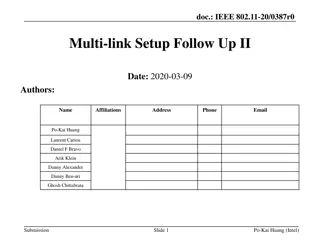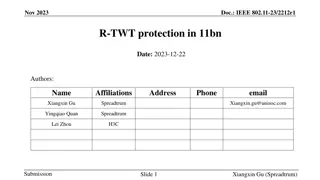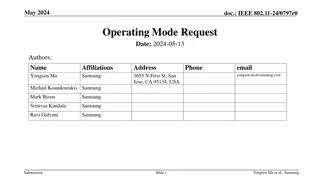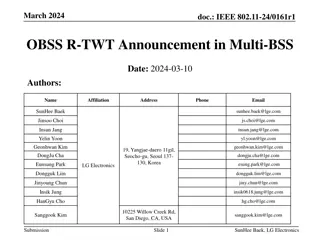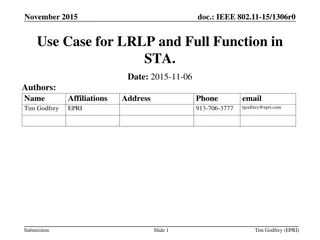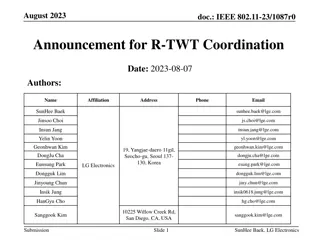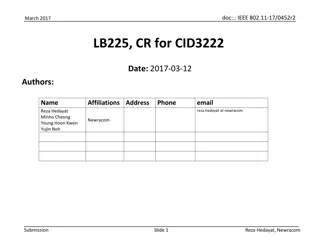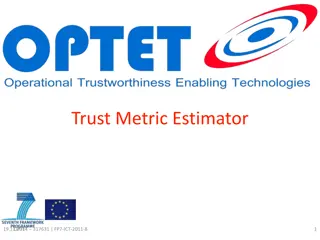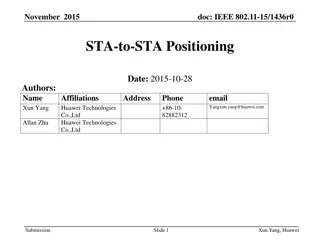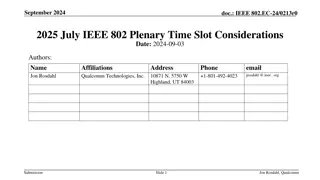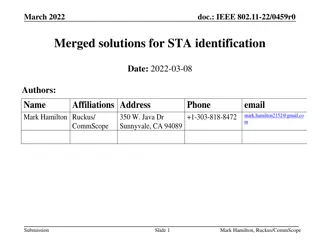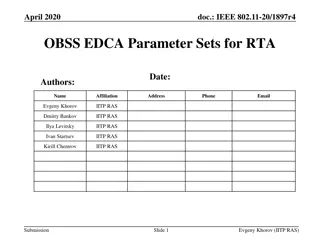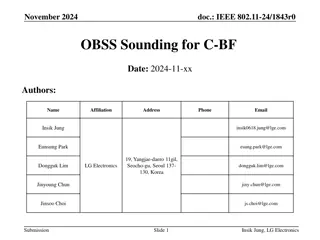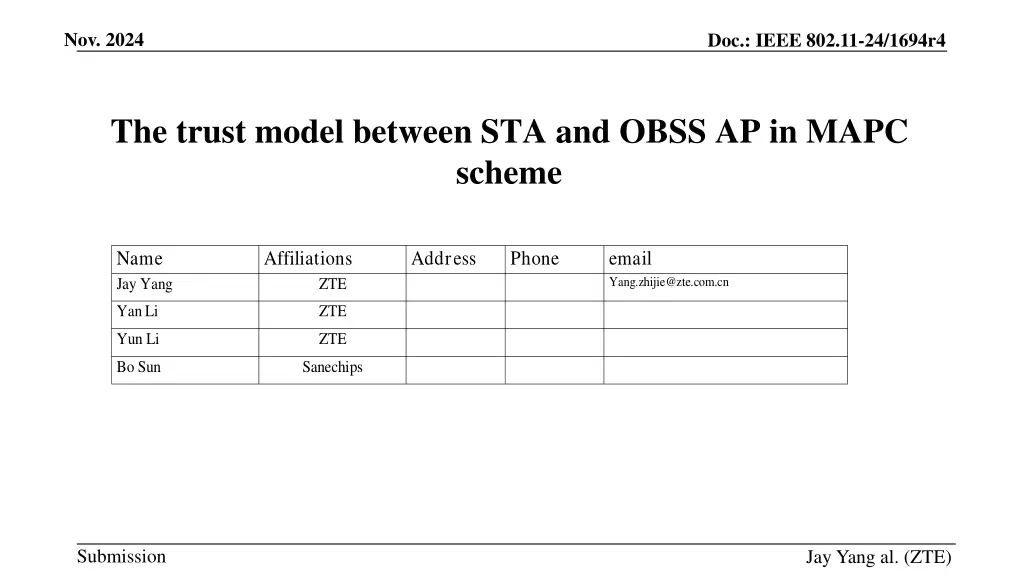
CSI Protection Mechanism Between STA and OBSS AP in IEEE 802.11-24/1694r4
Explore the trust model and proposed solutions for protecting CSI frames exchanged between STAs and OBSS APs in the IEEE 802.11-24/1694r4 standard to address user privacy concerns. Discussions include PTK sharing, negotiation, and group key encryption methods to enhance privacy during sounding procedures.
Download Presentation

Please find below an Image/Link to download the presentation.
The content on the website is provided AS IS for your information and personal use only. It may not be sold, licensed, or shared on other websites without obtaining consent from the author. If you encounter any issues during the download, it is possible that the publisher has removed the file from their server.
You are allowed to download the files provided on this website for personal or commercial use, subject to the condition that they are used lawfully. All files are the property of their respective owners.
The content on the website is provided AS IS for your information and personal use only. It may not be sold, licensed, or shared on other websites without obtaining consent from the author.
E N D
Presentation Transcript
Nov. 2024 Doc.: IEEE 802.11-24/1694r4 The trust model between STA and OBSS AP in MAPC scheme Name Jay Yang Affiliations Address Phone email Yang.zhijie@zte.com.cn ZTE YanLi ZTE Yun Li ZTE Bo Sun Sanechips Submission Jay Yang al. (ZTE)
Nov. 2024 Doc.: IEEE 802.11-24/1694r4 Introduction In Co-BF,11bn agreed on two new sounding sequences: Joint sounding and sequential sounding. In Joint and cross-BSS sequential sounding, the OBSS AP need to overhear the CSI frame transmitted by the unassociated STA. Meanwhile, the 3rd party also can overhear the unprotected CSI frame, and then sense the end-user activity between STA and it s associated AP, which will bring some user privacy issue. In this contribution, we would like to discuss the CSI protection between STA and OBSS AP. Submission Slide 2 Jay Yang, et al. (ZTE)
Nov. 2024 Doc.: IEEE 802.11-24/1694r4 Recap: CSI protection in 802.11bi SPEC(baseline of 802.11bn) The latest 11bi draft defines the protected CSI frame between AP and the associated STA. Before 11bi, the 3rd party may overhear the plain text of CSI frame, and then sense the end user activity between AP and the associated STA. In the latest 11bi draft,the individual addressed CSI frame is encrypted by the PTK,and thus the user privacy is enhanced. Submission Slide 3 Jay Yang, et al. (ZTE)
Nov. 2024 Doc.: IEEE 802.11-24/1694r4 Problem state and Motivation CSI protection defined by TGbi conflicts with the overhearing mechanism in sounding procedure proposed by TGbn Overhearing by the target OBSS AP in Co-BF sounding is a promising function and is widely discussed in 11bn group. But the target OBSS AP can t decode the overheard CSI frame once it s encrypted. Conclusion: The encrypted CSI frame causes overhearing mechanism become useless. Motivation We propose to define a new protected CSI mechanism between STA and OBSS AP in Co- BF sounding procedure to address the collision issue above. Submission Slide 4 Jay Yang, et al. (ZTE)
Nov. 2024 Doc.: IEEE 802.11-24/1694r4 The proposed CSI protection between STA and OBSS AP Opt1: PTK Sharing between AP and OBSS AP Pons: Individual addressed protected CSI frame can be reused,e.g. STA sends the protected CSI frame to its associated AP, and the OBSS AP can overhear the CSI and decode it with the shared PTK. Cons: The single PTK is used in both MGMT. and data frame, the OBSS AP also can decode the overheard data frame exchange between STA and its associated AP, which causes additional user privacy concern. Opt2: PTK negotiation between STA and OBSS AP Pons: Compared with the PTK Sharing approach, the user privacy concern can be mitigated. e.g. the STA encrypts the CSI frame via a separated PTK, which is negotiated between STA and OBSS AP. Cons: It only wok on cross-BSS sequential sounding procedure. That s, such solution can t be applied in Joint sounding procedure. Opt3(Preferred): The CSI frame encrypted by a separated group key Pons: Compatible with both cross-BSS Sequential sounding and Joint sounding procedure. Cons: No. Submission Slide 5 Jay Yang, et al. (ZTE)
Nov. 2024 The mainly procedures of group addressed protected CSI frame Doc.: IEEE 802.11-24/1694r4 1) The AP shares a separated group key(GK) to all the associated STAs. 2) The AP share the GK to the OBSS APs that participates Co-BF procedure. 3) STA sends the encrypted CSI frame in a group addressed manner in Cross-BSS sequential and/or Joint sounding procedure. To avoid the PN reuse issue, the AP may: Assign partial PN space to each STA(e.g. a different MSB 24-bit assigns to one STA), and each STA manages it s own LSB 24-bits(increment the PN after sending a encrypted CSI frame) Assign an increasing PN in ICF or BFRP in each sounding procedure, and STA encrypted the CSI frame via the assigned PN and GK. Submission Slide 6 Jay Yang, et al. (ZTE)
Nov. 2024 The following figure depicts an example of GK sharing and CSI encryption with the shared GK in Joint sounding procedure Doc.: IEEE 802.11-24/1694r4 Submission Slide 7 Jay Yang, et al. (ZTE)
Nov. 2024 Doc.: IEEE 802.11-24/1694r4 Summary Analyze the conflict issue between the protected CSI frame and overhearing mechanism. Compare all possible solutions and propose to the define the group addressed and protected CSI frame Compared with PTK sharing and PTK negotiation mechanism, a separated GTK sharing can be applied in both sequential sounding and Joint sounding procedure, and also it mitigates the end-user privacy concern. Propose a general procedure of GTK sharing for CSI protection including the PN assignment. Submission Slide 8 Jay Yang, et al. (ZTE)
Nov. 2024 Doc.: IEEE 802.11-24/1694r4 THANK YOU Submission
Nov. 2024 Doc.: IEEE 802.11-24/1694r4 Reference 1. 20/0123r0 Channel Sounding for Multi-AP CBF 2. 24/1542r0 Sounding Schemes for Coordinated Beamforming 3. 24/209r5 Specification Framework for TGbn 4. 24/1823r0 CSI in Sounding in CBF 5. 802.11bi draft 1.0 Submission Slide 10 Jay Yang, et al. (ZTE)
Nov. 2024 Doc.: IEEE 802.11-24/1694r4 SP1 Do you agree to have a mechanism to protect the CSI frame between STA and OBSS AP in sequential sounding and Joint sounding procedure? Submission Slide 11 Jay Yang, et al. (ZTE)
Nov. 2024 Doc.: IEEE 802.11-24/1694r4 Appendix: Sequential sounding in motion[#100] Submission Slide 12 Jay Yang, et al. (ZTE)
Nov. 2024 Doc.: IEEE 802.11-24/1694r4 Appendix: Joint sounding sequence in motion[#101] Submission Slide 13 Jay Yang, et al. (ZTE)

